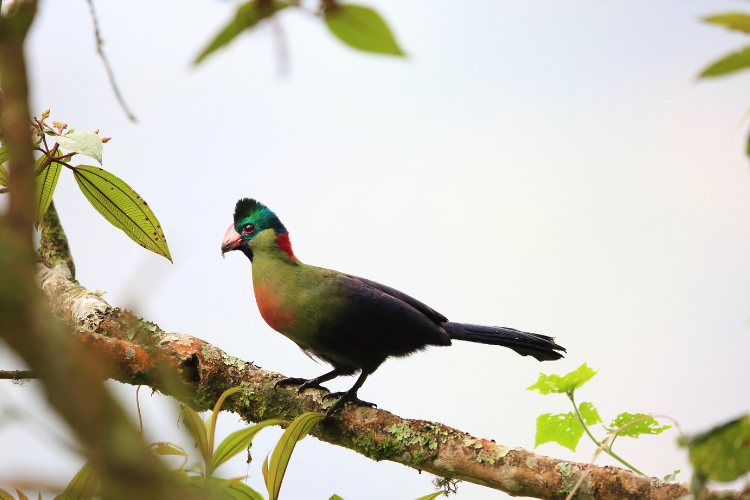5 Day Nyungwe Forest Montane Birding Safari
Home » 5 Day Nyungwe Forest Montane Birding Safari

Overview
Wrapped in misty ridges and steep valleys, Nyungwe Forest National Park is Africa’s richest and oldest montane rainforest and home to rare Albertine Rift endemics. This specialist birding pathway surveys some five days right into the evergreen park abyss, bamboo issues, tea estate outskirts, peat swamps, and canopy platforms to find rare and favored high-altitude species throughout the land. Regal Sunbird’s electric flash, Grauer’s Swamp Warbler’s shy appearances, and the veiled White-tailed Crested Flycatcher are the primary orientations for the extreme forest-monitoring and quality fields interpreted by wide encounter.
This program highlights not only the forest birds but also the entire montane system of Nyungwe. Warming up on Kigali wetlands, breaking open with tea plantations, combining open habitat with forest edge species, and adding night monitoring to the list. This slow-paced, expert coastal section provides time, top range, and an unforgettable high-altitude forest habitat.
Tour Plan
Upon arrival at Entebbe International Airport, you will meet your professional birding guide and transfer to your lodge. Depending on your arrival time, enjoy a short birding session at the Entebbe Botanical Gardens or along the shores of Lake Victoria, where species such as African Grey Parrots, Great Blue Turacos, and Palm-nut Vultures can be observed. Overnight in Entebbe.
The Uwinka Ridge trail features a dense evergreen forest filled with tangled vines and moss-laden tree trunks. Key targets include the Rwenzori Batis, Stripe-breasted Tit, Red-collared Mountain Babbler, and the White-tailed Crested Flycatcher. Mixed feeding clans are always a threat, so keep your footprints light and your binoculars focused as sunbirds, greenbuls, and flycatchers cruise past. After a brief lunch, proceed with exploration along the Uwinka core before traveling to the Nyungwe canopy walkway. Walk across the suspension bridge and identify the Purple-breasted Sunbird while the Mountain Masked Apalis and Dusky Crimsonwing flap their wings and mingle at the edges. At the end of the day, sit by the edge for a quiet watch as the diurnal birds roost and the Rufous-throated Aletheen calls out the Rumonero.
Drive deeper toward the Kamiranzovu caldera swamp. The habitat shifts into peat bog, bamboo clusters, and wet montane vegetation.
Focus on swamp specialists: Grauer’s Swamp Warbler skulking in dense reeds, Mountain Yellow Warbler hopping across low shrubs, and White-starred Robin in shaded understory. African Hill Babbler often gives melodic whistles nearby, and the trail occasionally yields Chimpanzee calls deeper in the forest.
Return to the lodge for a short rest. After dark, a guided night walk targets night species such as Rwenzori Nightjar, African Wood Owl, and possibly Montane Sombre Greenbul roosting low. We use soft lighting and a quiet pace to minimize disturbance.
Dawn walks along tea plantation margins where the forest meets cultivation. This is prime territory for Dusky Crimsonwing flitting through bracken, Purple-breasted and Rwenzori Double-collared Sunbirds feeding on flowering shrubs, and Olive Pigeon calling from tall trees. Yellow-eyed Black Flycatcher and Mountain Sooty Boubou often appear in shaded gullies.
Guests wanting primate encounters can join optional chimp-tracking in Cyamudongo or Gisakura Forest. Even without chimps, this zone is rewarding: White-bellied Crested Flycatcher, Shelley's Crimsonwing if luck strikes, and Regal Sunbird males shimmering on sunny perches. Afternoon rest at the lodge followed by gentle birding around forest edges.
Spend a full day exploring Kibale Forest, home to over 250 bird species. Guided walks take you under the dense canopy and along forest trails to spot African Green Broadbill, Green-breasted Pitta, White-naped Pigeon, and Great Blue Turaco. There are also excellent opportunities to see primates, including Red Colobus Monkeys and Chimpanzees. Overnight at the lodge.
Depart after breakfast, retracing the route toward Butare with birding pauses at marshes and roadside wetlands. Focus on Papyrus Canary, Carruthers’s Cisticola, and lesser-spotted wetland species like Fan-tailed Widowbird in grass patches. If time allows, walk museum gardens again for open-country birds.
Arrive in Kigali by late afternoon and drop off at the hotel or the airport. Safari concludes with a trip checklist review and a notable sightings recap.
Includes & Excludes
- Private 4x4 transport & fuel
- Lunch/snacks
- Professional birding guide
- Binoculars (on request)
- International flights & visa
- COVID-19 tests
- Travel insurance (required)
- Tips ($10/day guide, $25 porter)
- Personal expenses not specified in the itinerary

